#ancient roman fashion
Video
youtube
Getting dressed in Roman Britain
#fashion#ancient world#ancient rome#ancient roman fashion#britain#british fashion#shoes#jewelry#outerwear#fashion history#undergarments
186 notes
·
View notes
Text


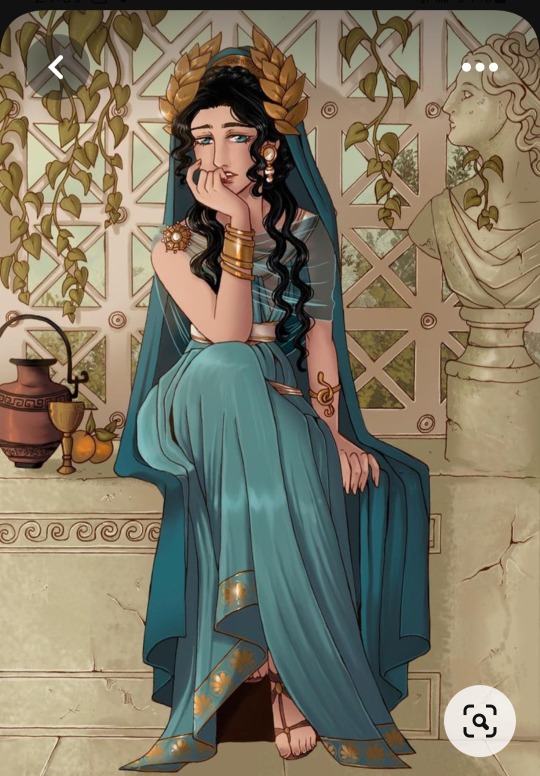


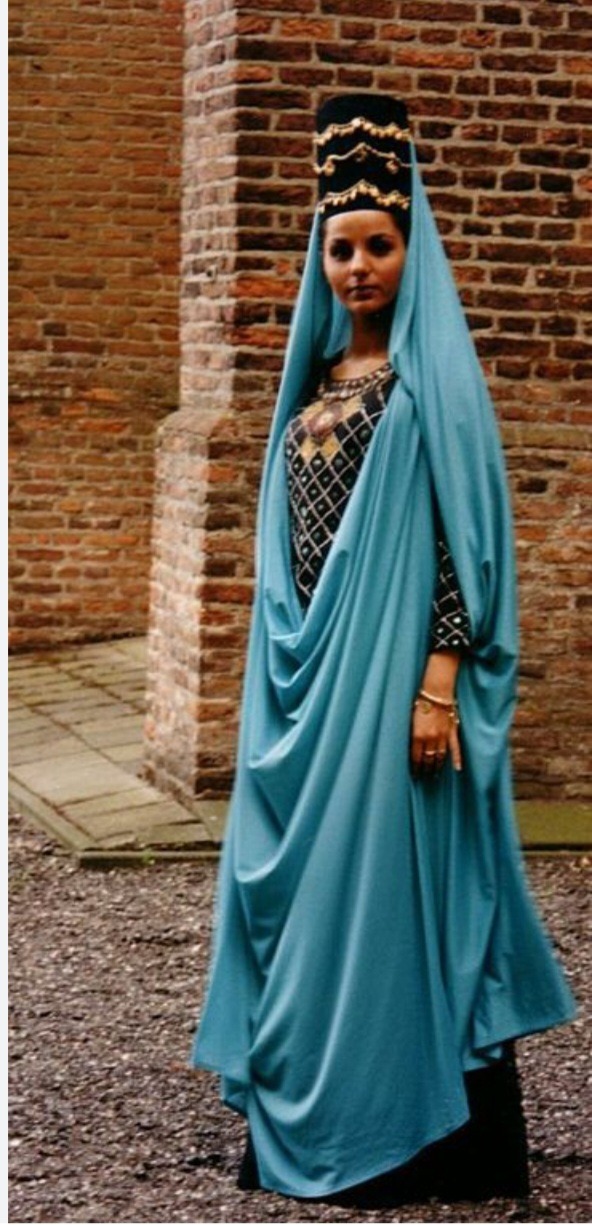
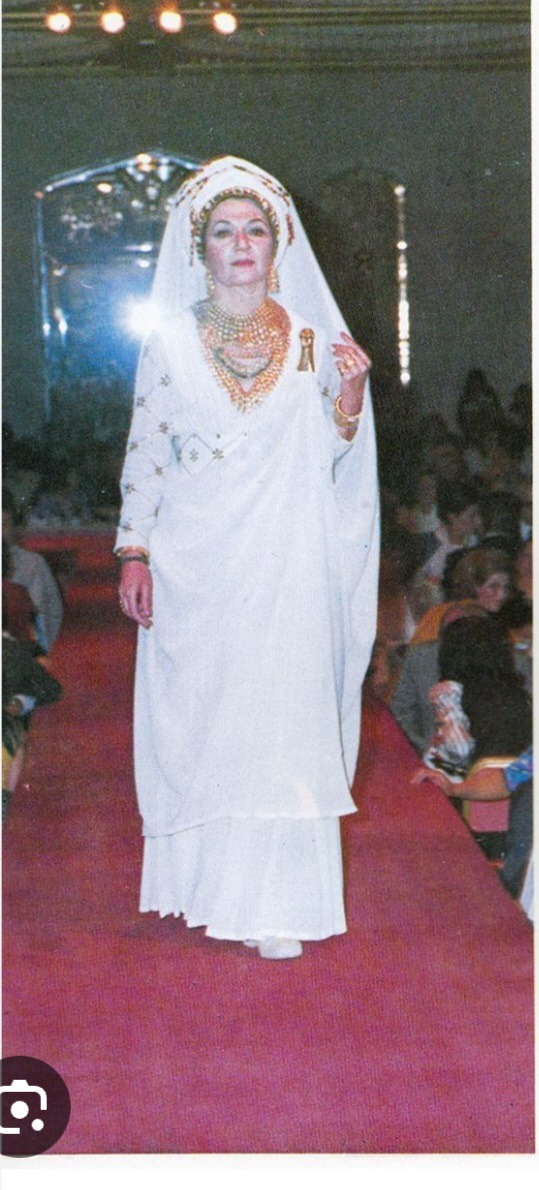
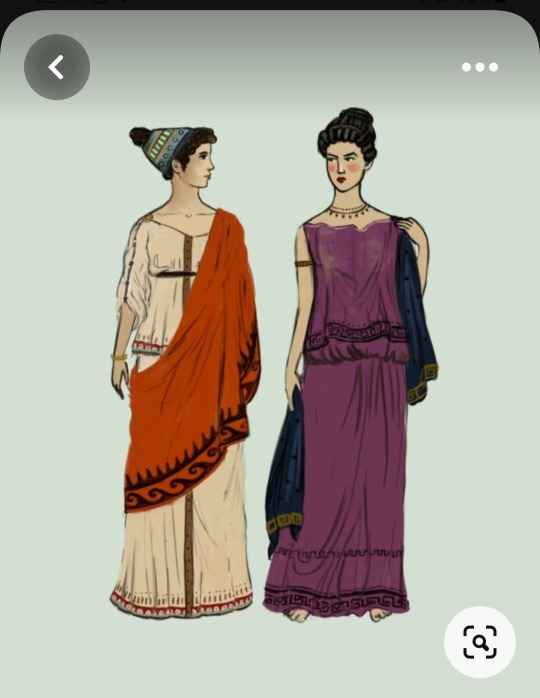
Some attires I can defo see Cleopatra VII wear 🤩🤩🤩🥺🥺🥺🥺
#ancient egyptian fashion#ancient roman fashion#ancient greek fashion#parthian empire fashion#FYI Cleopatra VII is GRECO EGYPTIAN#and she got iranic ancestry in her too btw#cleopatra vii
7 notes
·
View notes
Text
Time Travel Question 35: Ancient History XVI and Earlier
These Questions are the result of suggestions from the previous iteration.
This category may include suggestions made too late to fall into the correct earlier time grouping. Basically, I'd already moved on to human history, but I'd periodically get a pre-homin suggestion, hence the occasional random item waaay out of it's time period, rather than reopen the category.
In some cases a culture lasted a really long time and I grouped them by whether it was likely the later or earlier grouping made the most sense with the information I had. (Invention ofs tend to fall in an earlier grouping if it's still open. Ones that imply height of or just before something tend to get grouped later, but not always. Sometimes I'll split two different things from the same culture into different polls because they involve separate research goals or the like).
Please add new suggestions below if you have them for future consideration. All cultures and time periods welcome.
#Time Travel#Cybele#Ancient World#Trans History#Vesuvius#Pompeii#Roman Empire#Bog Mummies#Fashion History#Tyrian Purple#Bronze Age#Iron Age#Indigenous History#Egyptian Blue#Mediterranean#Mediterranean Sea#African History#Western Asian History#European History#Queer History#Epidaurus
244 notes
·
View notes
Text
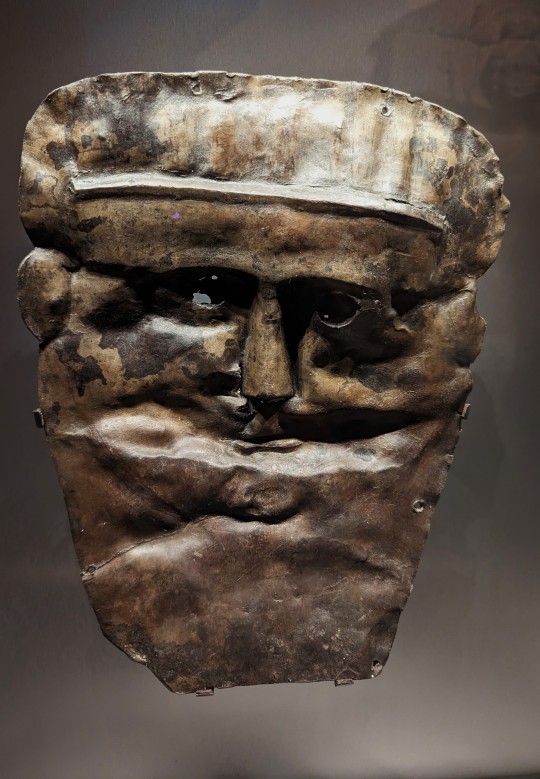
Religious Mask from Bath, England dated between the 1st and 4th Centuries on display at the Roman Baths Museum in Bath, England
Photographs taken by myself 2023
#art#archaeology#history#fashion#roman empire#england#english#ancient#iron age#roman baths museum#bath#barbucomedie
114 notes
·
View notes
Text
Bharani : the birth of Venus.
Part 1

Let's talk about ancient godesses of love and Bharani nakshatra.
I will base my research on the legend of the dead and resurrected god present in many religious myths coming from the middle east (ps : i'm sorry in advance for the grammar, syntax or spelling mistakes that you may find in this post, english is not my first language)
Bharani, situated in the heart of the rashi of aries is governed by Shukr: Venus but also by Yami and Yama in vedic mythology who are twins and gods respectfully of life and death.

Yama, the main deity of Bharani is said to be one of "8 celestial gatekeepers, who guards eight directional doorways or exits through which souls travel from an earthly plane to other planes of existence" making him the lord of Dharma since at one's death, he decides basing on his karma in what plane should one reincarnate.

Since Yama is responsible for directing the flow of life on Earth the association between bharani and the yoni becomes evident: the female reproducting system serves as a portal for souls to take on a physical form. So bharani as Claire Nakti perfectly described it relates to the feminine ability to receive, hold, nurture and ultimately transform through the womb.
Because Bharani aligns itself with all the feminine qualities by excellence it makes sense as to why Venus is it's ruler.
Venus is the roman name for the goddess Aphrodite: in greek mythology. She is said to be the goddess of love and beauty at large but also the goddess of war and sexuality. First because the ancient greeks saw the duality that links love to war and how they seem to come together through sex.
Also, Aphrodite is said to be born from the sperm of Ouranos when his testicules got cut by his son Saturn as he was always feconding Gaia, the Earth and causing her distress: he was acting cruel regarding their children. The sperm of Ouranus got mixed up with the foam of the Ocean creating Aphrodite which means "risen from the foam". So it was interesting to see that as Shukr also means sperm in sanskrit and it shows the origin of Venus as a fertility goddess too.

This conception of Aphrodite directly links her to ancient goddesses of love such as Ishtar or Inana in Mesopotamian/summerian mythology or Isis in egyptian mythology. Most of the time, these goddesses are the female counterpart of a god that was once mortal, got cursed, died and then came back to life for them to form an immortal couple.
In the case of Ishtar, her consort is Dumuzi or Tammuz and Osiris is the consort of Isis.
In Mesopotamian mythology :
Ishtar or Inana in sumerian is the goddess of love and sexuality, beauty, fertility as well as war because of her status as a " bloody goddess" mostly refering to her character in plenty of myths.
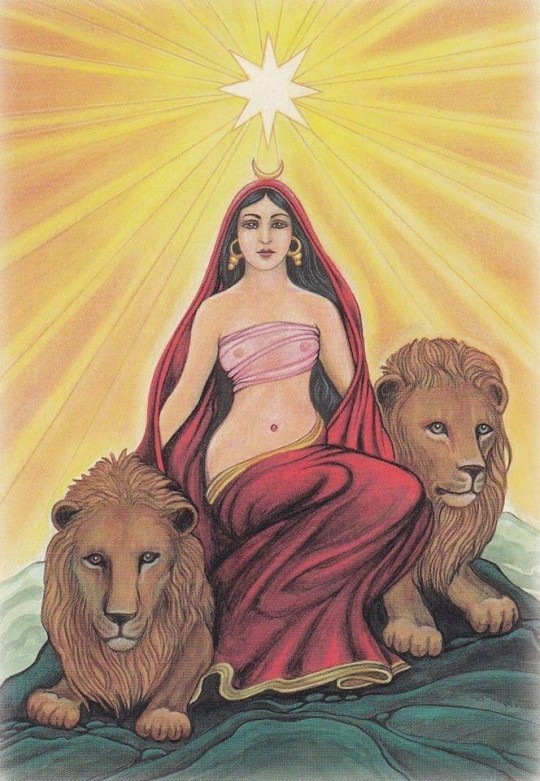
For example: in one story, she became infatuated with the king Gilgamesh, but the latter knowing her fierce reputation, refused her advances. As a result she got furious and unleashed the celestial Bull on Earth which resulted in 7 years of plagues. This celestial bull was later defeated by Gilgamesh and Endiku, and its corpse was throwed in front of Inana. Blinded by rage, she decided that as a punition Enkidu must die and sad at the death of his bestfriend Gilgamesh began his journey to find a cure to Death.
Bharani is a fierce or Ugra nakshatra meaning that its nature is agressive, bold and assertive in pursuing their goals. They are ruthless in the process of accompling what they desire the most and are inclined to extreme mood swings that can result in them to be "blinded" by their extreme emotions perfectly expressing the passionate character of Venus and her other equivalents in differents pantheons of antiquity.
Inana/ Ishtar's story with Dumuzi/Tammur begins as she was convinced to chose him by her brother Utu. Then she got married with the shepphard Dumuzi instead of whom she prefered in first the farmer: Enkinmdou. During the courtship, Inana prefered the fine textile of the farmer and his beer rather than the thick wool and milk of Dumuzi. The preference for the shepphard illustrates that at the time the Mesopotamian civilisation was known for their proliferent agriculture with the egyptians in the region, so this myth encapsulate the opposition between nomads and sendatary people at this specifific time period.

By the way, another symbol of Bharani is the cave and traditionnaly, the cave was used as a storage room for food. Also Bharani's purpose is Artha so these individuals are motivated to accumalate resources and provide safety and security, so Bharani can be linked to the exploitation of natural ressources like the soil illustrating the preference of Ishtar for the farmer. This is reinforced also by its Earth element.
So coming back to the myth, in a mesopotamian text called Inana's Descent to the Underworld, the goddess goes to Kur (hell) with the intent of conquering it, and her sister Ereshkigal who rules the Underworld, kills her. She learns that she can escape if she finds a sacrifice to replace her, in her search, she encounters servants who were mourning her death however she finds Dumuzi relaxing on a throne being entertained by enslaved girls. Enraged by his disloyalty she selects him as a sacrifice and he is dragged to the Underworld by demons.
He is eventually resurrected by Inana and they become an "immortal couple" as he may only come back to life for half of the year, being replaced by his son (?) who is also his reincarnation for the other half of the same years, so describing the cycle of regeneration of life.
Other mythologycal stories of goddesses in the near east describe a similar patterns:
The goddess Asherah is described as being the mother and the lover of her son Adonis.
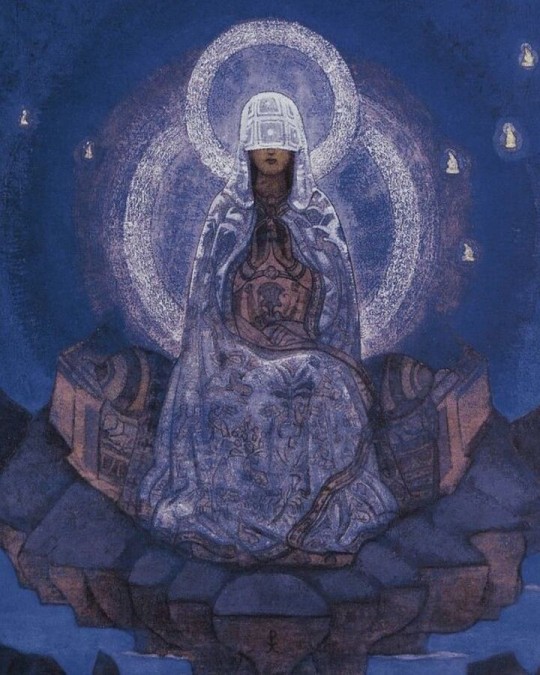
The goddess Cybele in the phrygian pantheon takes the form of an old woman as she described as the mother of everything and of all. And at the same time she is the consort of Attis who his her own son (wtf ?)
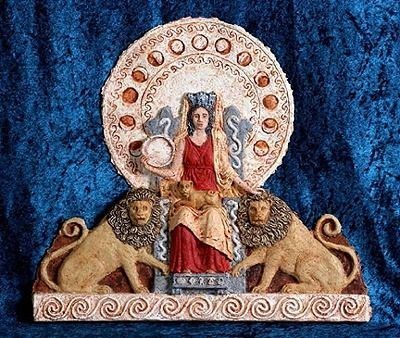
Also, Yama and Yami are implicated in a incestuous entanglement where his sister Yama wanted to lay with him however he refused establishing himself as a god with an infaillible moral campus.
All of these representations illustrate the relation between the masculine and the feminine, life and regenration which are all topics related to Bharani nakshatra. Women by their capacity to give life are seen as the source of life and therefore are eternal as they are able to regenarate themselves through daughters which are identical to them whereas man who is unable to reproduce by himself, is therefore mortal feels the need to associate with her to resurrect through a son who is identical to him. Bharani exiting as the embodiment of the link between "the father and the offspring" which is the feminine vessel.
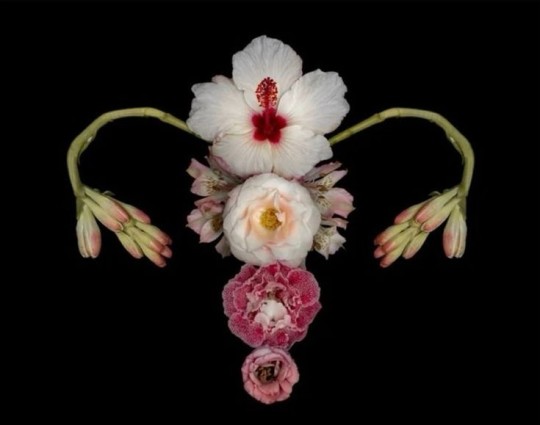

So this is certainly part 1, I think that these ancient myths are where Claire Nakti found her inspiration for her series on Bharani.
#vedic astrology#cinema#coquette#astrology#vintage movies#aesthetic#coquette dollete#fashion#vintage#movies#greek mythology#roman mythology#ancient egypt#bharani#chitra nakshatra#purva bhadrapada#purva phalguni#cowboy carter#venus#adonis
89 notes
·
View notes
Text
Ancient Necklace with Mosaic Glass Beads, from the Eastern Mediterranean, c.100 BCE-100 CE: this necklace is composed of 30 glass beads, most of which are decorated with stylized faces

From the John Paul Getty Museum:
The beads are made of multi-colored opaque glass and are decorated with heads and floral designs. The necklace is in good condition; some beads are chipped or cracked.

The exact origin of this piece is unknown, but it can be traced back to the Eastern Mediterranean, where it was likely made by a Greek or Roman artist.
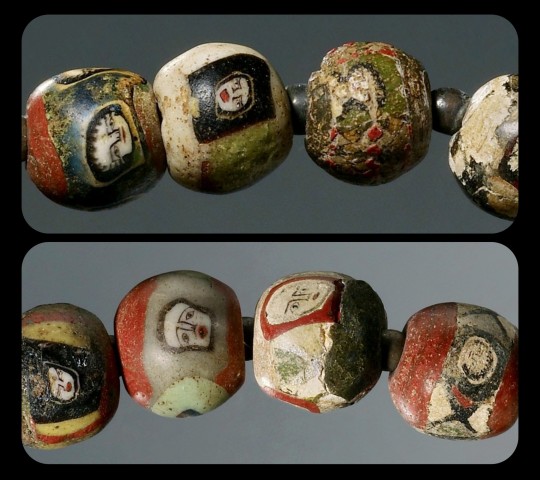
Each bead has a width of about 1.2cm (roughly half an inch); they're decorated with remarkably intricate details, and each face is depicted in its own unique style.

Sources & More Info:
John Paul Getty Museum: Necklace with Mosaic Glass Beads
#archaeology#artifact#history#ancient history#art#greek#roman#ancient art#antiquity#jewelry#beading#glass art#mosaic#crafting#greek art#roman art#eastern mediterranean#ancient#necklace#fashion#style#classical archaeology
75 notes
·
View notes
Text
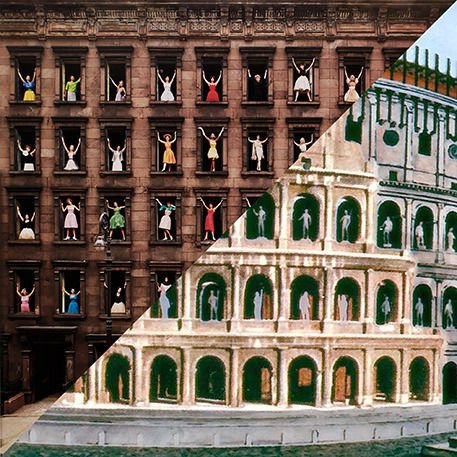
Ormond Gigli, Girls in the Windows, New York City, 1960
VS
Colosseum | Amphitheatrum Flavium, Roma, Italy, 72-80 (reconstruction drawing)
#photo#Ormond Gigli#photography#fashion#model#window#windows#closseum#roma#rome#archaeology#roman empire#ancient rome#ruins#ruin#italy#italia#tourism#drawing
108 notes
·
View notes
Text
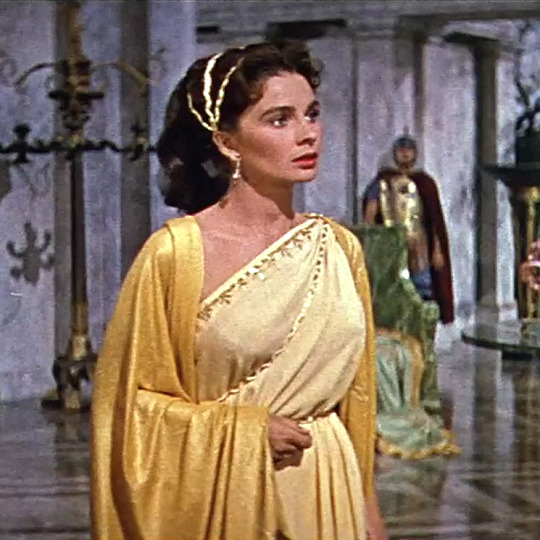

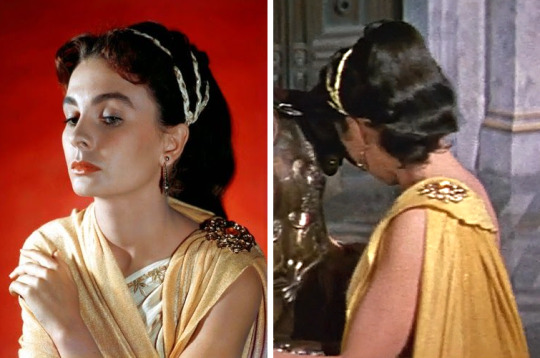


One Dress a Day Challenge
November: Oscar winners
The Robe / Jean Simmons as Diana
Year: 1953
Designers: Charles LeMaire and Emile Santiago
I'm impressed that they managed to avoid the "bullet bra" silhouette, which was all the rage at the time. I also like the edging on the soft yellow dress; it creates a pleasing effect when the draped layers overlap.
My family used to jokingly refer to this movie as The Robe that Ate Richard Burton. It seemed a bit overwrought on our small TV. It must have been quite a spectacle on the big screen, though.
#the robe#oscar winners#jean simmons#one dress a day challenge#one dress a week challenge#movie costumes#period film#1953 movies#1953 films#roman fashion#roman style#roman costumes#ancient roman costumes#ancient world costumes#off the shoulder#yellow dresses#yellow dress#the robe 1953#emile santiago#charles lemaire
99 notes
·
View notes
Text
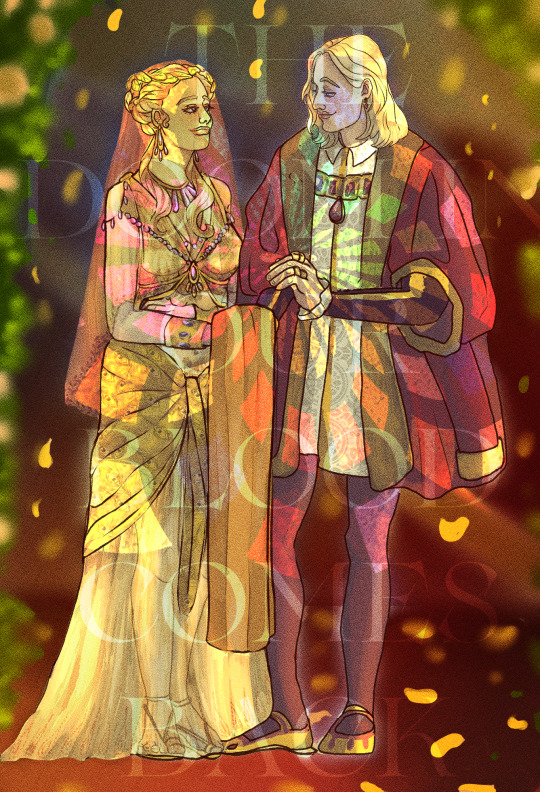

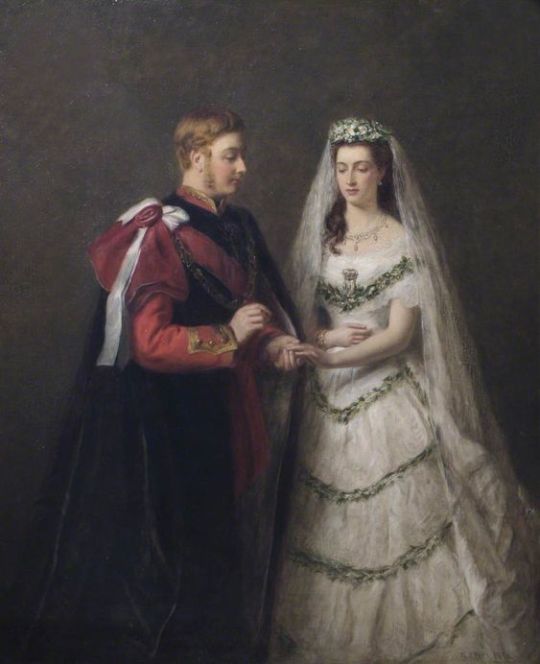

TDIOBCB challenge - day 7:
First Meeting - The Wedding of Prince Viserys and Larra Roagre in the Throne Room
"Many years later, the prince, reminiscing about how he and his wife had first encountered each other, would confess to his children, not without a blush, that even before laying eyes on her, the words Larra wrote during those years were enough to make him fall completely in love with her. He almost dismissed the revelation of her true appearance as playing any significant role in his infatuation. According to Prince Viserys, it was the eloquence and magnetic personality of his then-fiancée that enchanted him to the extent that concerns about her beauty took a back seat.
Whether this is the whole truth remains uncertain; however, it is worth noting that the marriage between Prince Viserys and Larra Rogare, though not initially under the most auspicious circumstances, evolved into a great love story that culminated in a long and happy union. If, before the arrival of his promised bride, the mind of the young prince was primarily occupied with the company of beautiful courtesans and high-born prostitutes, from the moment the stunning Lyseni maiden graced King's Landing, no other woman crossed the threshold of the young man's bedroom except her. This continued until her demise in 165 AC.
Every ounce of his energy, both physical and mental, from the day of their marriage, was devoted solely to his wife. She, no longer a girl, possessed not only extraordinary intelligence and culture but also breathtaking beauty, affirming the reality that the most beautiful women in the known world indeed hailed from Lys. Their union stood as a testament to the enduring power of love.
Still, even if, want to believe him for the sake of historical honesty, I must report the multiple testimonies of some members of the court, present at this marriage at the time, who claim that the newlywed groom, who had never seen his bride before the ceremony, remained anything but indifferent to her appearance.
According to them, during the grand entrance of the noblewoman, who arrived in the castle's Sept dressed in an exquisite and lightweight gown made entirely of golden silk that vividly revealed the perfect curves of her womanly form, accompanied by her fifteen ladies-in-waiting, the groom, was so dazzled by her dazzling beauty, that he needed to be supported by his brother Aegon to prevent himself from falling on the spot from sheer emotion.
The young prince, who had always been famous for being an easygoing lad, remained dumbfounded in front of her like a statue of salt throughout the ceremony, unable to find the words to express his wonder, to the point that, for a whole minute, he mistakenly recited the marriage formula almost three times before starting to recite his vows correctly.
It seems that the young prince was not the only one to be astonished by the entrance of the new princess. The same witnesses claim that even Prince Daemon was amazed by his new daughter-in-law, as evidenced by the widening of his eyes. During the celebration, he went so far as to congratulate his son conspiratorially, calling him "the luckiest man in the Seven Kingdoms."
- from TDIOBCB chapter 1
(warning: these illustrations are inspired by an AU Divergence and have nothing to do with canon (book or tv show) events and are not meant to be reposted outside of their contest)
#illustration#artists on tumblr#chiara cognigni's art#chiara's art#digital illustration#digital art#fanart#art#the doom in our blood comes back#pre asoiaf#asoiaf#a song of ice and fire#asoiaf fanfic#asoiaf fanart#tdiobcb#fanfic#fanfic ao3#ao3 writer#ao3 fanfic#wedding#lys#house targaryen#house rogare#essos#roman empire#ancient rome fashion#alexandra moloney#viserys the cleaver#viserys targaryen#visenya targaryen
47 notes
·
View notes
Photo

Maidens with Swords - Ancient Roman Empire
925 notes
·
View notes
Text

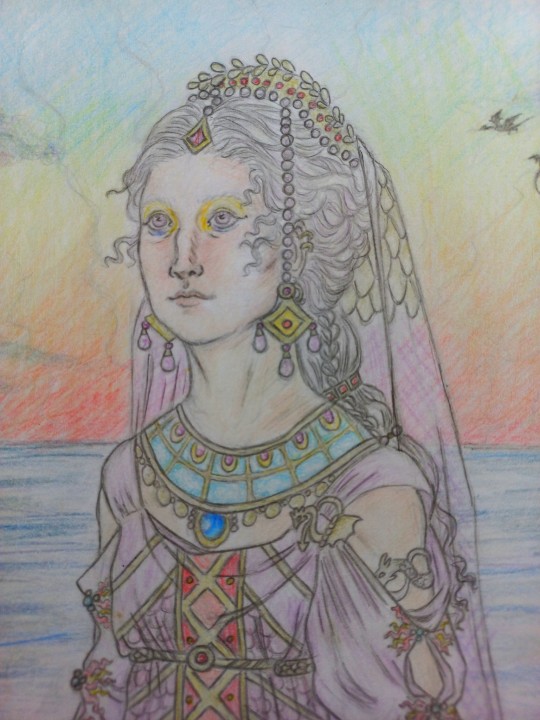
I made this one last December when I was listening about the roman punic wars while watching a beautiful sunset from my window and suddenly I thought of doom and prophecy and then this was just sitting here waiting for some colors. So here it is the dreamer herself, Daenys!!
#daenys the dreamer#daenys targaryen#asoiaf#fanart#house targaryen#valyrianscrolls#a song of ice and fire#my art#The quality is trash as much as this balcony that never heard about symmetry#When I finished it I was like#she doesn't have eyebrows but then I remembered that she has silver hair so that checks#the clothes are inspired by roman fashion#and the necklace is inspired by ancient egyptian necklaces#I don't think I've ever done a sunset with colored pencils so congrats to me#btw I love sunrises/sunsets so expect me to keep this background going
195 notes
·
View notes
Text
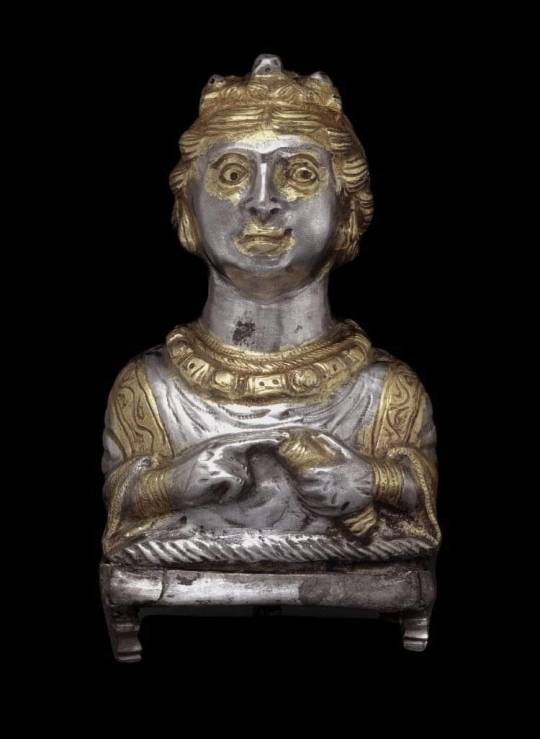
A silver pepper pot in anthropomorphic form. Roman Britain, buried in the 5th century AD, from Hoxne, Suffolk.
The pepper pot was found in 1992 by a farmer who was using his metal detector to search for a lost hammer. He found his hammer – it is now in the British Museum – but also a hoard of over 15,000 gold and silver coins, gold jewellery and numerous small items of silver tableware. The coins in the hoard establish that its burial took place some time after AD 407/8. Only a very wealthy family could have owned such treasures. We do not know the identity of the person who buried it but several objects are inscribed with the name Aurelius Ursicinus.
The pepper pot is in the shape of a wealthy well-fed woman wearing late Roman fashions. She wears a sleeved undergarment with tight gilded cuffs at the wrists, and a wide-sleeved over tunic with stripes of gilded and engraved decoration over the shoulders representing appliqued bands of embroidered or patterned textile (clavi).
Her golden (gilded) hair is done up in an intricate style that was often represented in late Roman art: the hair is parted in the middle, with rolls at the sides. The back hair is worked into a flat series of twisted locks at the neck that are drawn up over the back of the head, turned under at the front, and held in place with hairpins. Three knobs at the front and another at the crown of the head represent the ungilded hairpins.
Almond-shaped earrings and a necklace of large beads are depicted in relief and gilded, and there is additional gilding on the face, covering not only the eyes but the entire eye sockets, and the mouth, so as the flames from oil lamps flickered, the face would have seemed to come alive.
She holds a gilded scroll in her left hand, to which she points with the index finger of her right hand, probably to symbolise her learning and authority. We do not know if the figure represents a particular woman. ... It's ineffable.
Pepper was just one expensive luxury traded across the Indian Ocean in ancient times, as it did not grow in Britain or any other part of the Roman Empire. It was grown in India and to get to Suffolk, the pepper was transported by sea, river and over land.

https://www.britishmuseum.org/collection/object/H_1994-0408-33
http://www.teachinghistory100.org/objects/about_the_object/pepper_pot
https://upload.wikimedia.org/wikipedia/commons/thumb/1/1a/Hoxne_Hoard_28.jpg/800px-Hoxne_Hoard_28.jpg
spotted on Archaeologist Ticia Verveer's facebook page; https://www.facebook.com/100044382881604/posts/pfbid0UGcEJok8i67xeezyj2CLcKMJsbnLKAkWdy7NmP8TKZZ55opE4nU5fdVfqTSm7URXl/
#antique#ancient#archaeology#pepper#pepper pot#ancient history#ancient art#silver pepper pot#crowned figures#fashion history#ineffable inspiration#5th century ce#gilded figures#Aurelius Ursicinus#ancient roman art#ancient rome#ancient britain
179 notes
·
View notes
Note
Historical asks: 7, 10, 13
Thanks for the asks!
7. Historical dressing, uniform or costume?
I'm afraid I don't know that much about historical costumes unfortunately!
I'm going to be extremely predictable here and go with the Roman toga, maybe specifically the Toga praetexta. It may seem relatively simple but there were actually so many specific rules and social norms surrounding it. I find it fascinating that it was worn by both underage freeborn Romans and religious officers! Also, I just like the colour purple.

10. Pieces of art ( paintings, sculpures, lithographies, ect.) related to history you like most ( post an image of them)
I really like Eugène Delacroix's Liberty Leading the People! I know it's not about the first revolution, but I think it manages to perfectly capture the atmosphere. It just has this dynamic/epic vibe to it. There are depictions of death but also of hope.
Also, something about personifying abstract concepts (like Liberty and Marianne (symbol of the French Republic) as these larger than life female figures is just... *chefs kiss*
It's my laptop's lock screen for a reason!
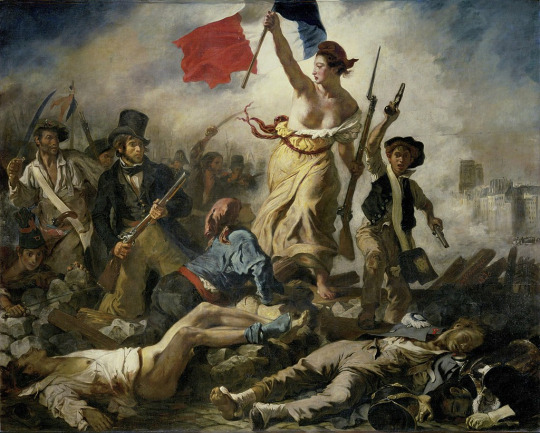
13. Something random about some random historical person in a random era.
Lucile Desmoulins wrote a story called What I would do if I were in her place in which she imagines that if she were Marie Antoinette, she would orchestrate a ritual execution for herself and let herself be burned at a stake. You can read it here!
She sometimes seems like a sweet, gentle soul and sometimes she is straight up savage. That's probably part of the reason why I adore her so much.
#thanks for the ask!#oh this was so fun but also resulted in me procrastinating from working on my thesis#oh well#frev#history#french revolution#ancient rome#roman republic#1700s#send asks#lucile desmoulins#ask game#marie antoinette#historical fashion#toga#art#frev community#tagamemnon
8 notes
·
View notes
Text
youtube
What clothes did Roman soldiers wear? Did they wear red?
from Imperium Romanum
63 notes
·
View notes
Text


Marble Statue of a Roman Lady from Italy dated to 240 on display at the NY Carlsberg Glyptotek in Copenhagen, Denmark
This coiffure was among the most popular from 240 and into the 4th century. It consists of three elements: artificially waved hair, free locks of hair along the fringes and a broad braid up the back of the head.
Photographs taken by myself 2018
#art#archaeology#history#fashion#roman empire#italy#italian#ancient#iron age#ny carlsberg glyptotek#museum#copenhagen#barbucomedie
116 notes
·
View notes
Text
‘Elsewhere, in [the Elder Pliny’s] far from coherent protests against the introduction of the gold ring as a status symbol to mark the equestrian order, he complains that legislation under Tiberius, which attempted to restrict the wearing of gold rings after common tradesmen and barkeepers had used them to protect themselves from magistrates, only encouraged the spread of the phenomenon among those of servile origin. Silver shoe buckles, paradoxically regarded as less trite and therefore more desirable than gold ones, became a luxury among women of plebeian status (luxu feminarum plebis), while embossed silver sword hilts attained fashion among common soldiers. Earrings formed of clusters of pearls called crotalia were the aspiration even of poor women (pauperes), and Pliny acknowledges the potency of 'luxury' in providing status markers, quoting the women as saying that ‘a pearl was a woman's lictor in public.’
From the journal article The Social Spread of Roman Luxury: Sampling Pompeii and Herculaneum by Andrew Wallace-Hadrill.
32 notes
·
View notes